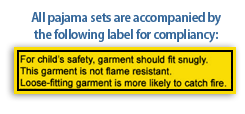 My children do not wear sleepwear ladened with flame retardants. I always seek out 100% cotton pajamas that are made to fit snugly and thus do not require passing flammability tests. The Consumer Product Safety Commission (CPSC) explains:
My children do not wear sleepwear ladened with flame retardants. I always seek out 100% cotton pajamas that are made to fit snugly and thus do not require passing flammability tests. The Consumer Product Safety Commission (CPSC) explains:
What is the purpose of the children’s sleepwear flammability standards?
To protect children from burns, these rules require that children’s sleepwear must be flame resistant and self- extinguish if a flame from a candle, match, lighter or a similar item causes it to catch fire. The rules cover all children’s sleepwear above size 9 months and up to size 14 and require that
(1) the fabric and garments must pass certain flammability tests; or
(2) be “tight fitting” as defined by specified dimensions.
I always assumed the flame retardant sleepwear requirement was for in case of a house fire, but the CPSC states, “Children are most at risk from burn injuries that result from playing with fire (matches, lighters, candles, burners on stoves) just before bedtime and just after rising in the morning,” resulting in 300 emergency room visits a year.
Pediatric Safety explains:
The Consumer Product Safety Commission (CPSC) considers flame retardant treated pajamas to be safe. Generally, the chemicals used on pajamas or pajama fabrics include chlorinated and brominated flame retardants, inorganic flame retardants such as antimony oxides, and phosphate-based compounds. In the 1970s, the CPSC banned brominated Tris and removed chlorinated Tris from being used on children’s pajamas after they were found to mutate DNA and identified as probable human carcinogens. These chemicals were removed from children’s sleepwear after it was found that children were exposed from their treated sleepwear. So, these two particular chemicals won’t be used, but what is actually used on pajamas is difficult to discover: just try asking a retailer what particular flame retardant is used on any particular item of sleepwear.
Unfortunately, chlorinated and brominated flame retardants are contaminating the environment and accumulating in the human body. For example, polybrominated diphenyl ethers (PBDEs) have been linked to damage to the nervous and reproductive systems and impairing thyroid function. And you generally can’t tell what flame retardant is being used on any particular clothing item. And you can’t really wash the flame retardants out. The regulations require that the fabrics demonstrate their flame resistance after being laundered at least 50 times.
That is why I chose organic cotton, snug fitting sleepwear, but why is the CPSC recalling such sleepwear made by Sage Creek Organics?
Hazard: The garments fail to meet the federal flammability standards for children’s sleepwear posing a risk of burn injury to children. The garments are being recalled because they do not meet the tight-fitting sizing requirements.
Incidents/Injuries: None reported.
Description: This recall involves long sleeve boys’ and girls’ pajama sets that were part of the Enchanted Forest Collection, Forest Friends Collection or Golden Dragonfly Collection. The sets were sold in sizes 6 months to 4T in the following colors: cream and green; dark blue and light blue; and, pink and lilac.
I’m confused, as Sage Creek Organics states on their website that all jammies come with the snug-fitting tag warning consumers they do not contain flame retardants.
The concern with flame retardants and their pervasiveness in our environment, even when certain kinds have been banned, should outweigh the limited number of emergency room visits. 300 is really a small number when you consider the population size of the United States, and I think an effort on parent safety education would be more beneficial then poisoning our children and environment with flame retardants. We don’t leave matches or lighters or candles around our children before bed or in the morning. I just think that reasoning is quite ridiculous given the problems with flame retardants.
I’ve never seen the “after being laundered 50 times” part before! We have used hand-me-downs because I just assumed that it would wash out over time, but no more! When I buy, I go for organic cotton and size up because the “right” size is so tight they’re hard to get on. We don’t let our toddler smoke in bed, so I’m not too worried about it, haha!
Great post – thank you for bringing attention to this. I know people are getting smarter, but it seems too many products are taking advantage of the “organic” label and not protecting their customers to the fullest. Your last paragraph was a zinger 🙂